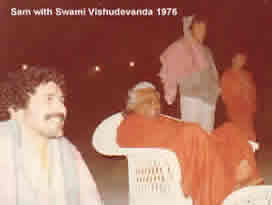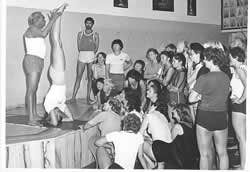17 Cents, an Apple,
and a Flower |
How To Participate in a Traditional |
|
Student-Teacher Relationship |
 Larger Font Larger Font
 Smaller Font Smaller Font |
I first began doing yoga in Los Angeles during the 1970's and I quickly became intrigued. Soon after completing an initial series of once-a-week classical style classes held in the local community center, I moved to San Diego where, in addition to my daily personal practice, I began taking classes five to six-days-a-week in a school where the teachers had studied in India with BKS Iyengar. There was nothing "casual" about my yoga because I knew early-on it was to be my life's work.
I wanted to leave San Diego and travel the world, to seek out master yoga teachers and learn all I could. I sold most of my possessions and was willing to spend everything I had because I felt certain that in the future, I would be able to sustain myself by teaching yoga.
A few days before leaving San Diego to begin my travels, I heard about a free yoga class in Balboa Park. Although I already considered myself to be a "serious" yoga student studying in a "serious" yoga school, I wanted to experience what a free yoga class, given outdoors in a public park, might be like. It was a gentle, classically oriented two hour yoga class ... presented on the lawn under an expansive canopy of trees.
It was a perfect Southern California morning. Neither too cool nor too warm, the day was as mellow as the teacher's voice. After his gentle class, the teacher placed his hat on the lawn and although not directly asking for payment, he said he would accept donations.
For thousands of years, yoga was considered spiritual work with its teachers depending upon their students for lodging, food, and the other necessities of life. When yoga came to the West, it was argued by purists that Western yoga teachers should not charge for classes ... like the yoga teachers of India and like the teacher in Balboa Park, yoga should be taught for sustenance or donations only.
When that mellow yoga class in the park ended and after all the students were gone, I was curious about how much the yoga teacher had received and I looked into the hat: At the bottom lay seventeen cents, an apple, and a flower.
By the time I left San Diego, I knew I was going to be a full time yoga teacher and I knew I was going to open a yoga studio somewhere ... but I didn't know where. But before that could happen, I knew I needed to learn more, so I began traveling throughout North America, Europe, and India, where I ended up studying with many of the world's best yoga teachers.
Sam with Swami Vishnu Devananda in 1976 |
Sam with BKS Iyengar in 1978 |
 |
 |
By the late 1970's, I sold the remainder of my assets so I could rent commercial space and open a yoga center. However, it was abundantly clear that I could not pay the bills and keep the doors of my yoga studio open on ... seventeen cents, an apple, and a flower.
When I established my first school, I was still torn between the historical perspective of teaching for donations and directly asking students to pay for their classes. I dealt with that conflict by establishing a sliding fee schedule and I was quick to offer my classes for free to anyone who even suggested that money was a problem.
In the next few years, I learned a number of important lessons about yoga that went well beyond charging for classes and paying the bills. Among them, I learned that people seldom place value on what they don't pay for. That certainly rang true from the beginning of my yoga-teaching career; for whenever I did not charge, lessons were neither valued nor appreciated ... and unlike students who paid, students who did not pay quickly drifted away.
On the other hand, something special happens when yoga students "support" their teacher. It doesn't matter if that support is in the form of money, or giving their time, materials, or expertise that furthers the ability of the yoga teacher to teach. And so it has been for thousands of years, for when students "support" the yoga teacher, a spiritual component is created that both nourishes and reinforces the student-teacher relationship.
For over thirty years, my students have been good to me. They have supported me both directly and indirectly; and even when chronic illness forced me to limit the number of outside classes I taught, (see Biography), I was still fully involved with yoga by continuing my personal practice, by studying the mechanics of yoga, by teaching privately, and by sharing my developing understanding of the mechanics of yoga through this web site, which has been a work in progress for the past nine years.
If you consider yourself to be a serious yoga student, and if my teaching through this website contributes to your yoga practice and education, there are ways you can participate in the traditional student-teacher relationship other than paying to read this e-book or by making monetary donations:
- You can critically read this e-book and post them on our Forum with your comments, questions, recommendations, and feedback. Your critical evaluation of the material in this e-book helps me to refine existing content and generates additional material for everyone's benefit.
- You can purchase my books and video lecture directly through my website rather than through other book sellers.
- When you "click through" on the Amazon.com logo and search engine on the left-side of each page, anything you purchase generates a small commission that is used to support the website.
- And of course, monetary contributions beyond payment to access The Mechanics of Yoga are used to offset the cost of website maintenance. Credit card contributions may be made using PayPal, the internet's most secure and popular payment system or you may donate by check or money order Click here if you wish to donate in support of this website and my work.
 Return to top
Return to top


